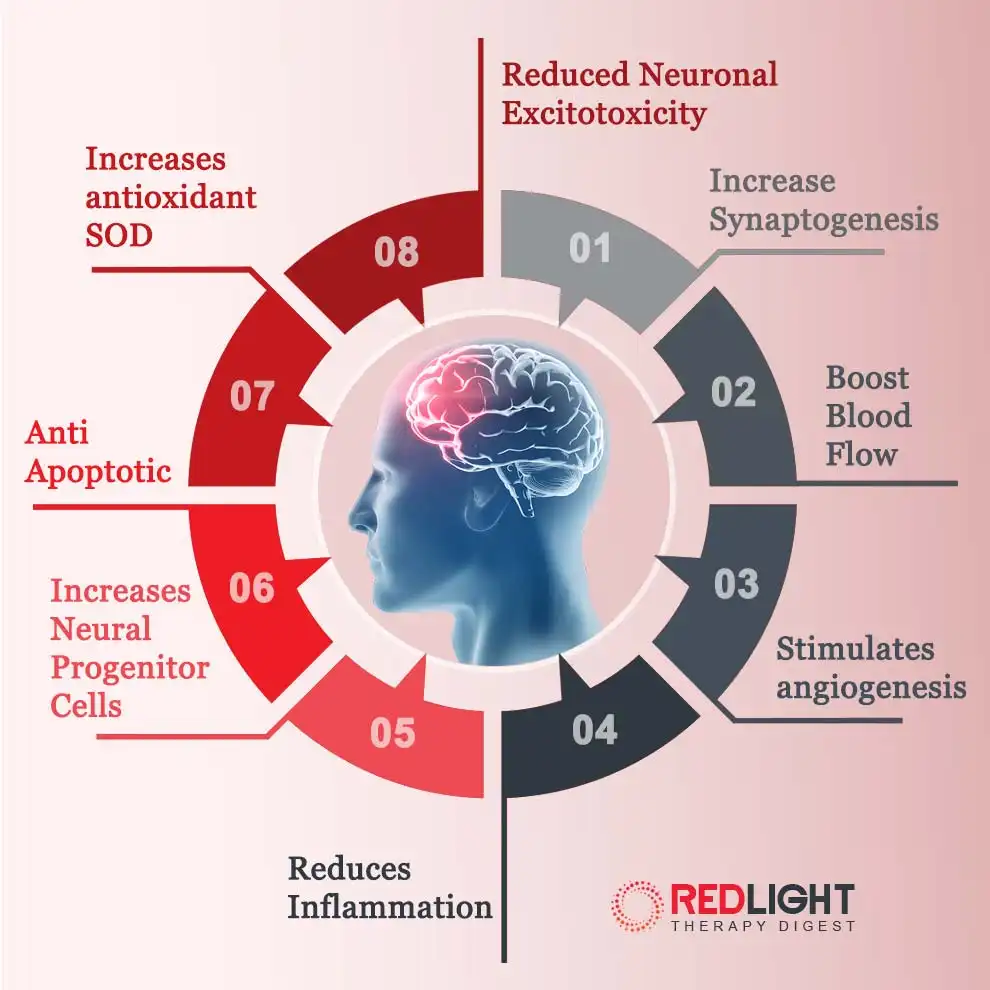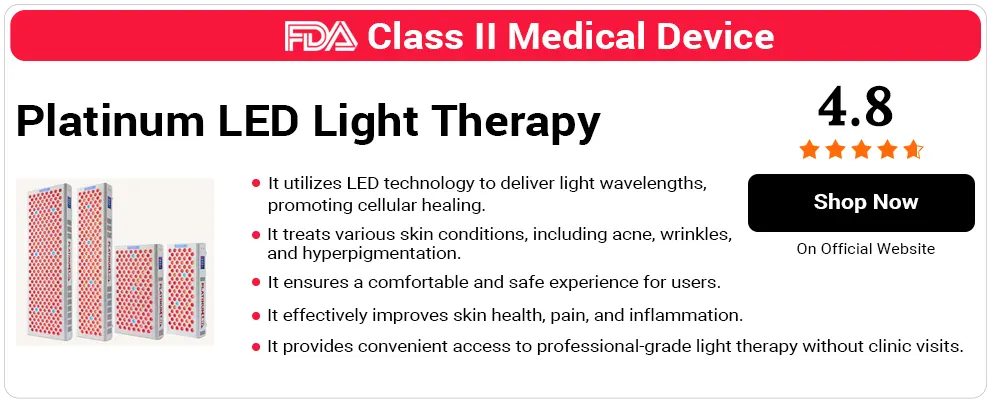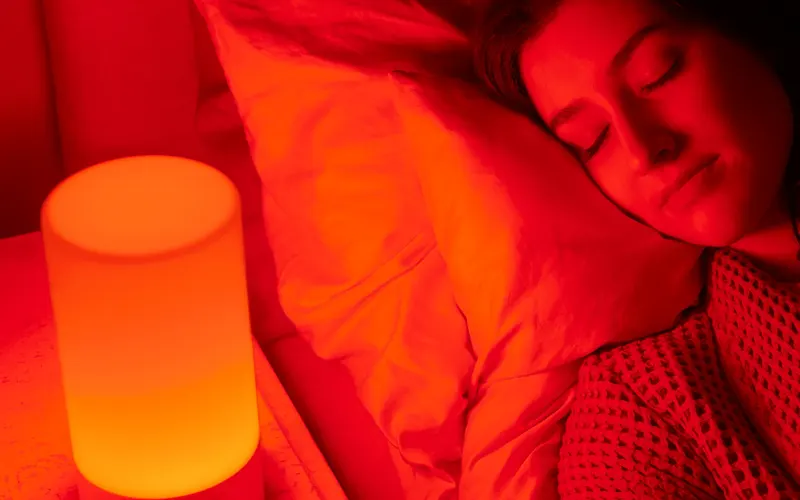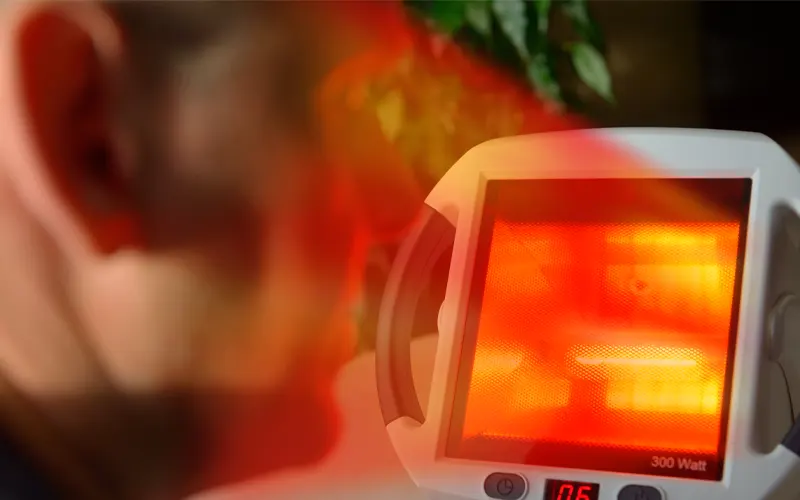Introduction to Red Light Therapy and the Brain
Among the many health and wellness of advantages red light therapy, this technology also has potential use for brain health and cognitive function. LED light enhances levels of key brain chemicals, boosts cerebral blood flow, decreases inflammation, and repairs damage.
The effects of red light therapy for brain function are impressive and notable, leading to improvements in memory, focus, concentration, learning, information processing, and more. Red light therapy may lift brain fog, improve sleep quality, and relieve depression and anxiety.
Rebecca Edelmayer, Ph.D., senior director at the Alzheimer’s Association, discussed the use of laser therapy for the brain, explaining:
We’re starting to see companies looking at similar, noninvasive methods of stimulating the brain. For example, brain stimulation devices have been applied to other neurodegenerative diseases like Parkinson’s to try to prevent degeneration of brain cells [1].
How Does the Light Penetrate to the Brain?
There are several means to transmit LED light to the brain, the most common being though the forehead. However, research indicates that the device can also effectively deliver photons through the nose, mouth, or behind the ear, and ideally a combination of all of the aforementioned methods.
In addition, one of the most powerful methods for treating the brain is to deliver treatment to the entire body via a large panel rather than solely to the forehead and other areas of the face.
we covered mito red light therapy reviews that are beneficial for brain health, support calmness, relaxation, improve mood, and proper sleep.
Can Your Brain Effectively Absorb Light?
Both red and infrared light from wavelengths of about 610-1000nm can absorb several millimeters into the brain according to the research, although beyond that the results are ineffective. Wavelengths over 1000nm deliver thermal heat, which is not helpful at providing brain benefits.
One research study in Lasers in Medical Science by Caerwyn Ash and Michael Dubec, et al found that red light at 610 nm to 670 nm penetrates at a depth of about 4-5mm, and infrared light at 810 nm, 830 nm, 850 nm penetrates at a depth greater than 5mm [2].
Supporting Scientific Evidence: Photobiomodulation and Brain Health
Recent research has highlighted the potential of red light therapy, also known as photobiomodulation (PBM), in promoting brain health, especially in the recovery from traumatic brain injuries (TBI). A study titled “Photobiomodulation improves functional recovery after mild traumatic brain injury”, published in the journal Bioengineering & Translational Medicine, provides evidence of the benefits of near-infrared light treatment in improving recovery outcomes for individuals with mild TBI.
The study, conducted by researchers at the University of Birmingham, demonstrates that near-infrared light can help restore brain function by reducing inflammation and promoting cellular repair. This adds to the growing body of evidence supporting the use of red light therapy for neurological conditions.
What Does Red Light Therapy Do to the Brain?
LED therapy works by sending photons of light into the body at different wavelengths, as we explained in our NovoTHOR Review. This stimulates the mitochondria of the cells to elevate levels of ATP (adenosine triphosphate), which provides cellular energy to all of the cells in the body including the brain.
“RLT affects the brain, it principally works by promoting cellular repair and reducing oxidative stress, which in turn can support neuron health and function. This could lead to improvements in cognitive abilities, mood regulation, and even potentially slow down the progression of certain neurodegenerative diseases” observed Mike Breslin, owner of ProMed DME.
A review published in the Journal of Cerebral Blood Flow and Metabolism by Maria Erecinska and Ian A. Silver discussed the role of ATP in brain function [3].
When it comes to the brain, for the most part high wavelengths in the infrared spectrum of 750-1000nm are necessary for powerful benefits due to how deeply it penetrates. However, red and infrared light combined may also have optimal benefits.
Another important factor is irradiance. In order to deeply penetrate the skull the device requires high irradiance, so keep this in mind when buying an at-home product.
The light stimulates improved cerebral blood flow for enhanced alertness, mental focus, and general brain health. It promotes repair, decreases inflammation, protects the cells and their lining, and improves communication between nerve cells.
There’s some evidence to support the use of red light therapy for neurological disorders and improve functioning. A review by Michael R. Hamblin published in BBA Clinical explored the research on the role of photobiomodulation in treating brain disorders [4].
LED light therapy also synthesizes higher levels of key brain neurotransmitters involved in learning, memory, information procession, mood, and anxiety like dopamine, acetylcholine, serotonin, and GABA. This may lead to significant improvements in cognitive functioning and mental health. Consider using another red light therapy device in your daily routine, as reviewed in The Cera System Review, to treat memory loss, dementia, mental health concerns, and other neurological disorders.
A chapter from the book Hippocampus by Claudia Jara, Débora Buendía, Alvaro Ardiles, Pablo Muñoz and Cheril Tapia-Rojas discussed the benefits of transcranial red light therapy in preventing age-related hippocampal memory impairment [5].
We covered a review of the best sad lamp, which mainly focuses on mental health disorders and helps build a better brain by improving mood and calmness.
Can You Use Red Light Therapy For the Brain At Home?
There are a wide range of at-home devices you can now purchase which have the potential to improve brain health and mood. Naturally you should make sure you buy a high quality, safe product from a reputable manufacturer.
It’s important to note that you should not use red light therapy to treat serious medical or mental health issues, brain injury, or neurological conditions. You should use the technology as a complement to medical treatment, and with the approval of your physician.
We covered the red light therapy for anxiety and mental health article which promotes better mental health, reduces anxiety, and helps in managing mood swings.
Is Red Light Therapy Safe For the Brain?
As we expressed in our Joovv red light reviews, LED light therapy is a safe technology with few risks or potential side effects, as long as you use it according to the directions. In particular, follow instructions for treatment times, number of sessions per week, and distance from the panel.
When you select a device, purchase from a reputable manufacturer which has FDA cleared products and manufactures according to rigid safety standards. In addition, ensure that the device has zero or very low EMF levels emissions.

Benefits of LED Light For the Brain
These are some of the best red light therapy benefits for the brain:
Neuroprotection For Conditions Like Parkinson’s and Alzheimer’s Disease
Treatment with LED light shows great promise in protecting from the development of conditions like Alzheimer’s and Parkinson’s disease, due to its neuroprotective potential.
A current research review in Photonics by Michael R. Hamblin discussed the powerful neuroprotective effects of light therapy and its ability to prevent cellular damage and death, as well as prolong cell longevity [6].
A review article in Frontiers in Neuroscience by Daniel M. Johnstone, et al presented the evidence supporting the benefits of red and infrared therapy in arresting neuronal death in degenerative brain conditions like Alzheimer’s and Parkinson’s disease [7].
Enhanced Brain Cell Functioning
As we have explained, LED light therapy stimulates the cell mitochondria to increase levels of ATP, which has the direct result of powering all of the body’s cells.
This increase in energy improves the functioning of the cell by repairing damage, decreasing inflammation, and improving intercellular communication. The 2019 review by Michael R. Hamblin also concluded that LED light improves the functioning of brain cells [6].
Improved Blood Flow To The Brain
LED light therapy can boost the production of nitric oxide in the body, leading to better circulation including cerebral blood flow. This has a positive effect on alertness, attention, and decreasing brain fog.
The elevated blood flow brings needed oxygen and nutrients to the brain, and may even help in the healing of neurodegenerative conditions and brain injury.
According to Psychologist Giulia Bianchi Red Light Therapy holds significant potential for accelerating the recovery process from brain damage. The therapeutic effects of red and near-infrared light wavelengths penetrate the scalp and skull, reaching deep into brain tissue. Here, they stimulate cellular repair, enhance mitochondrial function, and reduce inflammation – all crucial components of the healing process. Whether the brain damage stems from traumatic injury, stroke, or neurodegenerative conditions, RLT offers a non-invasive, adjunctive approach to support recovery and optimize neurological function.
A study published in Photobiomodulation, Photomedicine, and Laser Surgery by S. Gregory Hipskind, MD, PhD, et al concluded that pulsed transcranial red and near infrared light enhanced cerebral blood flow in veterans with chronic traumatic brain injury which elevated cognitive function [8].
Reduced Inflammation And Oxidative Stress
The benefits of LED light therapy extend to destroying harmful free radicals in the brain, lowering levels of oxidative stress and promoting healing of any damage to cells and tissue.
This technology also decreases the inflammation which can lead to further damage and possibly cause neurogenerative or psychological conditions.
A study by Michael Hamblin published in AIMS Biophysics discussed the anti-inflammatory effects of photobiomodulation and its mechanisms [9].
Increased Stem Cell Production
Stem cells generate the production of other cells in the body, making them crucial for our development and functioning. There’s evidence to indicate that LED light therapy synthesizes new stem cells, improving mental functioning and helping to heal damage or injury.
A review in Medical Lasers by So-Young Chang and Nathaniel T. Carpena, et al examined the effect of photobiomodulation on stem cells and its importance in regenerative medicine [10].
Some of the benefits that show the most potential are as follows:
Improves Cognitive Function
LED light may boost levels of brain neurotransmitters like acetylcholine, dopamine, serotonin, and GABA and improve cerebral flood flow. This could promote enhancements in memory retention and retrieval, and speed up learning and information processing.
It’s specialized devices that emit red light, like the SunBox Sunlight Jr., which can be applied directly to the head or body and primarily focuses on cognitive function. The red light therapy is painless and has no harmful side effects.
A study in the Journal of Optics by Madison Hennessy and Michael R Hamblin showed that photobiomodulation improved memory and learning in mice [11]. In addition, the increase in key brain chemicals may have an impact on improving mental focus and ability to concentrate.
Improved Recovery From Stroke
One of the most promising benefits of LED light therapy is in the treatment of patients who have suffered a stroke. An ischemic stroke, which is most common, occurs when there’s a block in cerebral blood flow.
This can cause damage to areas of the brain and loss of key motor functions, partial paralysis, and in some cases pain. However, there are a number of studies which show the great benefits of red light therapy in reducing pain and improving functioning.
A clinical trial by Marcele Florêncio das Neves and Mariana César Ribeiro Dos Reis, et al published in Lasers in Medical Science using 808 nm infrared light showed a reduction in pain and an improvement in muscle fatigue in stroke patients. They suggested the treatment may lead to an increased recruitment of muscle fibers [12].
In addition, Michael R. Hamblin’s review in BBA Clinical cited both animal and human studies showing the benefits of red and infrared therapy in improving neurological functioning in stroke patients [4].
Accelerated Recovery From Traumatic Brain Injury
There are some demonstrated benefits of red light therapy for traumatic brain injury, including enhancements in many areas of functioning. As we discussed in our review another red light therapy for brain health called Platinum red light therapy has demonstrated its benefits for the brain, joint pain, and muscle damage.
A pilot study on LED light therapy and brain injury in the Journal of Neurotrauma by Margaret A. Naeser and Ross Zafonte, et al found that 6 weeks of treatment 3 times a week with infrared therapy improved social, interpersonal, and occupational functioning following traumatic brain injury [13].
Improvement In Psychiatric Disorders
One of the great benefits of low level laser therapy is its impact on mood and mental health. Its increase in brain neurotransmitters like serotonin and dopamine could boost positivity and decrease depression, and GABA helps lower stress and anxiety.
A study published in Behavioral and Brain Functions by Fredric Schiffer and Andrea L Johnston, et al concluded that one treatment of photobiomodulation to the head provided great psychological benefits to patients with major depression and anxiety within 2 weeks [14].
Treats Degenerative Brain Disorders and Slows Cognitive Damage or Decline
LED light therapy may be effective for slowing the cognitive damage and decline associated with conditions like Alzheimer’s’ disease.
The laser light may work to repair cellular damage, reduce inflammation, improve intercellular communication, and boost levels of key neurotransmitters like acetylcholine and dopamine.
A review in Photonics by Michael R. Hamblin discussed the potential benefits of photobiomodulation in treating Alzheimer’s disease [6].
Is Red Light Therapy an Effective Complement to Medications and Psychotherapy?
Red light therapy can play a valuable role as a complementary treatment in conjunction with traditional approaches such as medications and psychotherapy, we consult cosmetic dermatologist Laura Geigaite. She told us Its ability to address underlying cellular dysfunction and promote neurochemical balance makes it a synergistic addition to conventional mental health interventions.
Red light therapy stands as a promising frontier in the realm of mental health interventions. The wealth of scientific evidence, coupled with its non-invasive nature and minimal side effects, makes it a compelling option for those seeking to optimize their mental well-being. As both a medical doctor and psychologist, I encourage individuals to explore the potential benefits of red-light therapy as part of a comprehensive approach to mental health care.
Laura further added “I often advise my clients to view red light therapy as part of a holistic mental health strategy. When used in combination with medications and psychotherapy, it can enhance overall treatment outcomes. However, it’s crucial to consult with a healthcare professional before incorporating red light therapy into an existing mental health regimen, ensuring a tailored and comprehensive approach.”
Red light therapy can potentially be used as a complementary treatment alongside traditional medications and psychotherapy, says Elvis Rosales, Clinical Director at Align Recovery Centers. He says It’s non-invasive and painless, making it a suitable addition to a comprehensive treatment plan. However, it’s crucial to consult with a healthcare provider before starting any new treatment regimen.
For expert insights and community discussions on the effects of red light therapy on brain health, visit our Question & Answer section.
FAQs
Q: Is Red Light Therapy Good For Your Brain?
A: Yes, there are many benefits to using infrared light or red and infrared combined to promote cognitive benefits like improving memory, focus, attention, information processing, brain fog, and learning. In addition, there’s evidence of the efficacy of red light therapy for brain inflammation.
This technology may also improve mental health by decreasing depression and anxiety, and it could benefit neurodegenerative conditions like dementia.
Q: Does Red Light Therapy Increase Dopamine?
A: Yes, there’s evidence that stimulation with LED lights can increase levels of dopamine, as shown by a study published in Biomedical Optics Express by Jinn-Rung Kuo and Shih-Shian Lin et al [15].
Q: Does Red Light Reduce Anxiety?
A: There’s evidence to indicate that LED light therapy, ideally infrared or a combination of red and infrared light, stimulates levels of brain neurotransmitters like GABA to decrease stress and anxiety. GABA does this by blocking certain nerve impulses from the central nervous system.
A study by Hua-Jun Feng and Chris Kao, et al published in the Journal of Neuroscientific Methods showed that stimulation with infrared light can accelerate GABA transmission [16].
Q: What is the Best Light Therapy For Dementia?
A: In order to improve neurological brain conditions like Alzheimer’s disease, deeply penetrative infrared light is the most effective. These are the only wavelengths which are powerful enough the delve deep into the brain, promoting repair, reducing inflammation, and balancing levels of key brain chemicals to help improve symptoms of dementia like memory loss.
Q: Can Red Light Therapy Help Memory?
A: According to the evidence, wavelengths of infrared light penetrate the brain and could increase levels of the key brain neurotransmitters involved in memory, which are acetylcholine, dopamine, serotonin, and GABA. This has the potential to improve memory, including in people with dementia.
Conclusion
There’s a significant amount of scientific support for the benefits of LED light therapy in enhancing cognitive health. The evidence indicates that infrared light or a combination of red and infrared wavelengths may significantly improve memory, learning, focus, and mood, and repair damage associated with neurological conditions, similarly covered in Vielight reviews.
In addition to clinic treatment, there are a number of red light therapy at home panels for sale which could help enhance your cognitive functioning, mood, and wellbeing. If you look at the red light therapy reviews 2023 from some of the leading manufacturers, many user mention the positive benefits of the treatment for brain health.
It’s important to get approval from your physician to use this as part of your treatment plan, and do not rely on red light therapy alone to treat serious neurological or mental health conditions. In addition, as we mentioned in our review of Novaalab red light therapy, choose a safe, FDA cleared device from a trusted, reputable company.










